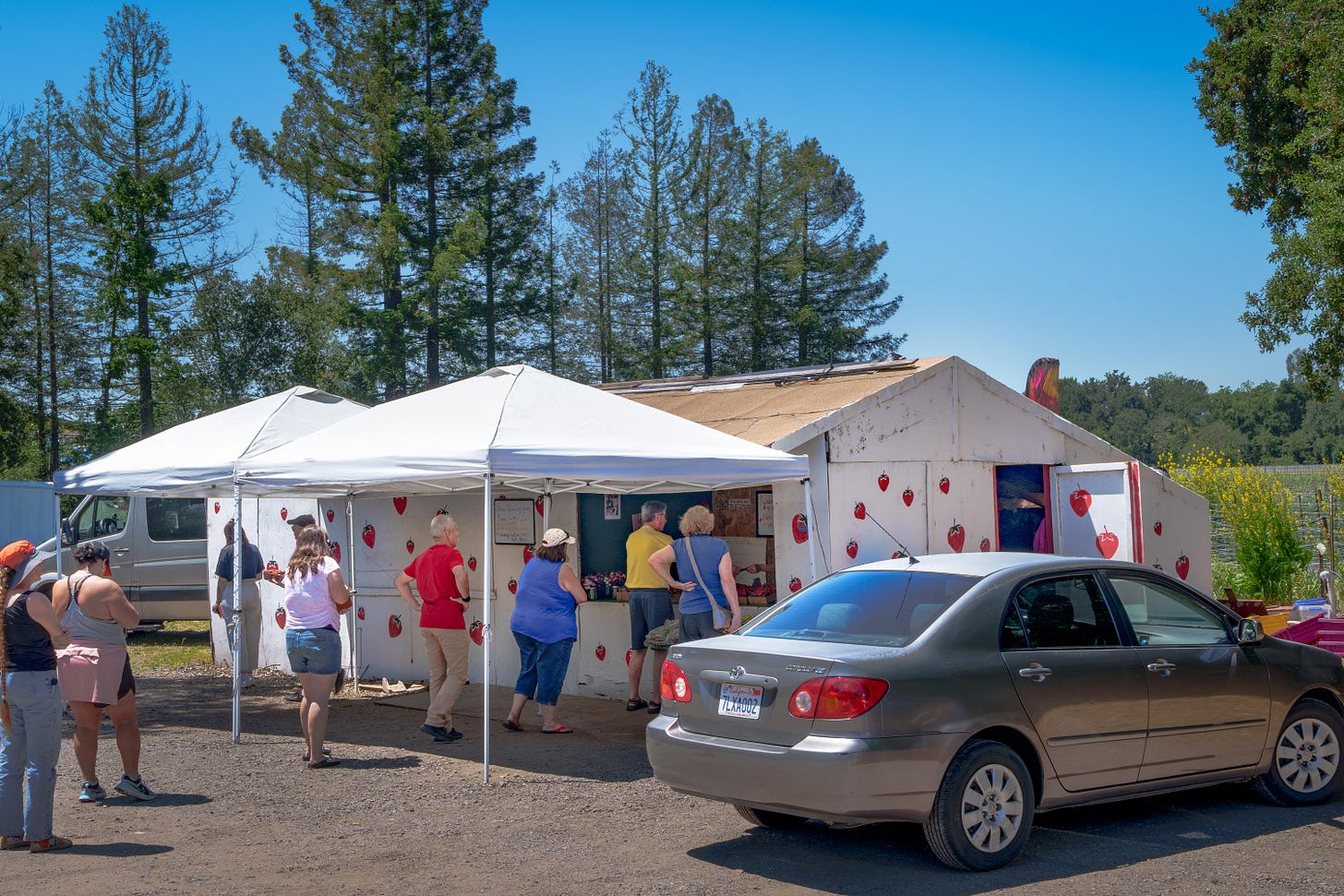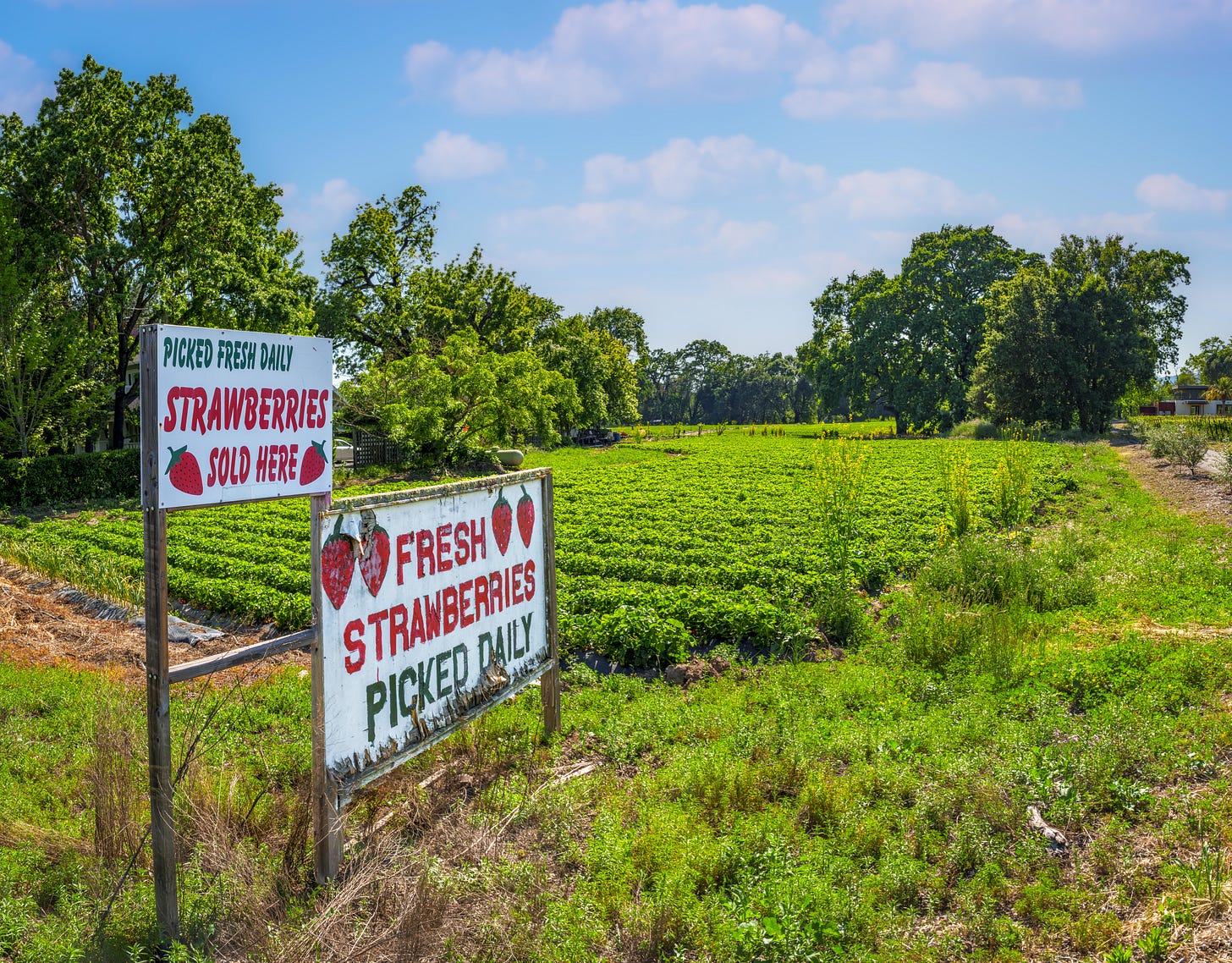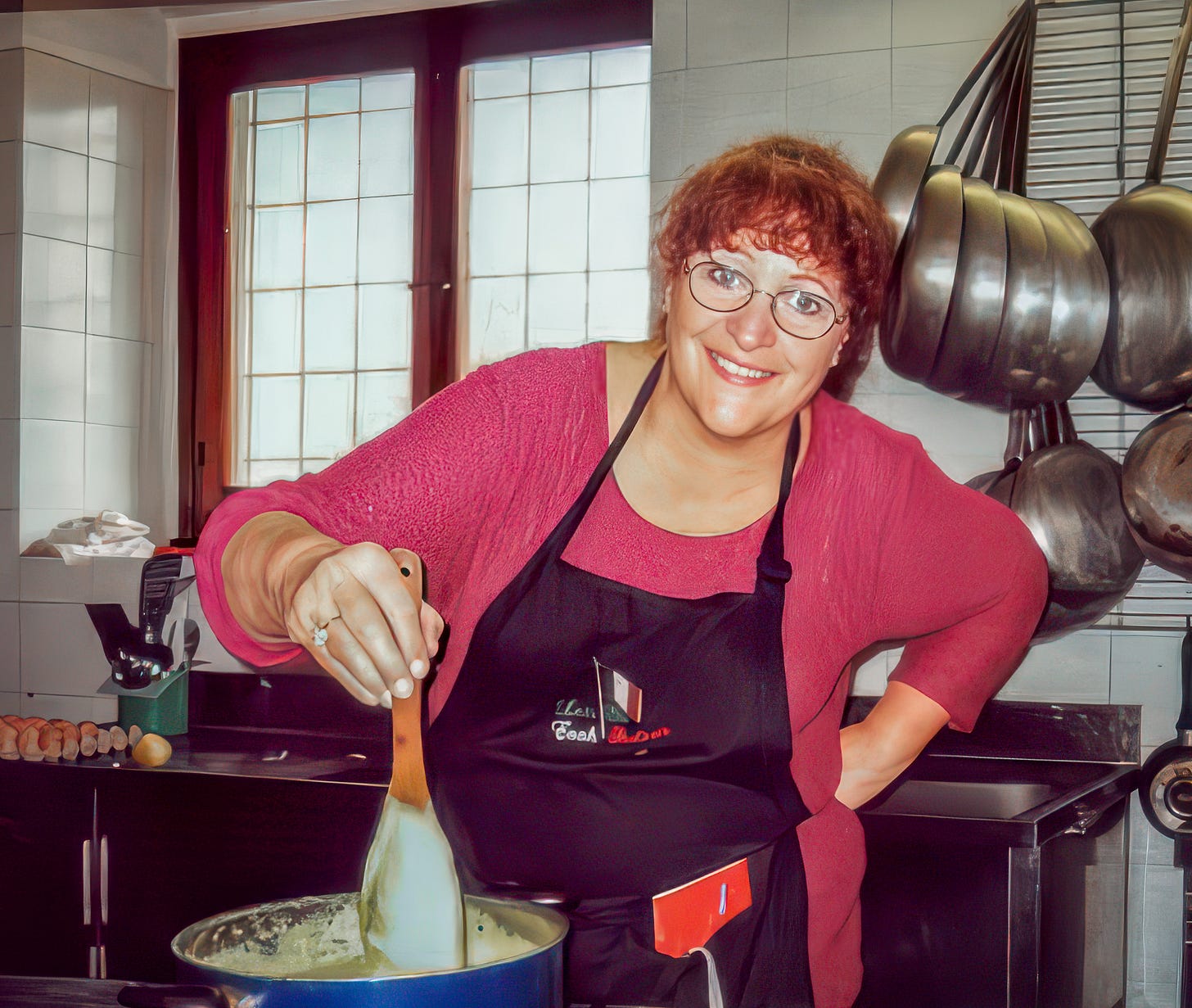The Silverado Trail Strawberry Stand: Cultivating a Flavorful Legacy Through Family Harvests
By Sasha Paulsen and Diane De Filipi
“The Silverado Trail strawberry stand is open,” a friend emailed me earlier this year. “Summer is coming.”
He is not the only one in the valley who waits for the banners to go up, announcing strawberries are in at the Saetern Family Farm on the Silverado Trail, just beyond the intersection where Trancas Street turns into Monticello Road.
Mouang Saetern opened the stand 23 years ago, and on a busy Sunday afternoon, as cars were pulling in and out of the parking spaces to claim their fresh berries, she took time to talk about her idea and how it grew.
Her children and grandchildren help her, Saetern said, not only with the stand but with their farm in Suisun. In addition to strawberries, grown there as well as in the field behind her Napa stand, they plant a variety of vegetables and fruits.
How many children? “Too many,” she said with a laugh. “I have 10 children and 17 — no 18— grandchildren.”
Her grandson, Ryan, was selling baskets of berries on this day, while Saetern was in the back arranging bouquets of sweet peas, which are blooming just now in the field behind the stand.
“My favorite flower,” she explained.
From a simple beginning, the fame of Saetern’s strawberries has spread throughout the valley. At restaurants and wine dinners, menus will specify that these are not just any strawberries but “Silverado Trail Strawberries.”
“The French Laundry, Bouchon and other places,” she said nonchalantly. “My daughter is in charge of that.”
On a warm summer day, you can pick up a basket of just-picked berries still warm from the sun, and most likely you’ll be seduced by their fragrance into eating them before you get home.
And go back for more.
On any given day, you might also find other produce as well. Along with her strawberries on this Sunday, she had a table full of spring onions, bags of just-picked sugar snap peas and the bouquets of sweet peas. She brings in stone fruit as it ripens from other farms that she likes.
This year, due to the exceptionally cold and rainy winter, the produce season is getting a later start, Saetern said.
“Usually we have cherries before Mother’s Day,” she said, “but not this year.”
As the season goes on, she will have squash, beans and super sweet corn.
And, for lack of a better word, it all tastes real.
I bought a watermelon there last year. Saetern’s daughter, Nai, chose it for me, a heavy oblong one that I lugged to the car. I took it home and cut it open to find a vivid red color and a flavor so true that one bite took me back to long-ago summers, sitting on a swing and spitting out seeds, hoping they’d grow into my own plants.
It’s the place to find an old-fashioned summer in a stand on Silverado Trail.
Does she have a secret?
“No, no secret. The berries are just good.”
What do you do with strawberries if you make it home without eating them all?
For ideas I turned to Diane De Filipi, who for many years wrote a popular cooking column, “Italian Lessons,” inspired by her family background and her many trips to Europa. De Filipi, formerly from Los Angeles, left the corporate world for Napa Valley in the 1990s. There she first worked as manager of Wine Country Inn and then purchased and operated the Ink House bed and breakfast in St. Helena.
In the early 2000s she sold the Ink House. I met her when she came into the newspaper office, wondering if I would like to write a story about a proposed project she had in mind.
“I’ve decided to take my hospitality show on the road,” she said.
She was proposing to take small groups of food enthusiasts to the Villa Campestri in the hills above Florence for a week of cooking with the resident chef.
She wanted to keep it affordable, she said, so it could be for guests for whom this was a grand adventure, not just one more trip to Europe.
I became one of them, going first to the Tuscan villa, and then, as her destinations expanded, to Rome and to the magnificent Château de la Barge in Burgundy. I was not the most industrious of cooks, but I did enjoy meeting her growing circle of Europeans chefs and hoteliers and, of course, eating the fine meals.
De Filipi lost her home in the Napa hills in the 2020 wildfires but found a home in Napa last year. Now settled into to her cozy new house, she told me she was not only planning to restart her cooking adventures with a trip to Tuscany this fall, but she was also ready to start writing again.
“Great,” I said. “What do you do with strawberries?”
Strawberry Season
By Diane De Falipi
These bright beauties call to us from farm stands and farmers markets. Although it’s easy to eat an entire little basket of them, part of the fun can be creating recipes for the luscious sweet strawberries for which you have been waiting.
There are many wonderful dessert recipes for strawberries, but they are far more versatile than you might imagine.
First, a little history. People have been eating wild strawberries for at least a thousand years. While the origins of strawberry plants are unknown, they seem to be indigenous to North and South America as well as to Europe and Asia.
In the 1600s, colonists discovered the fruit in the New World and shipped the plants to Europe. In 1714, a Frenchman discovered the Chilean strawberry and brought it to France. This species boasted a larger size than wild strawberries, but they were not hardy and were quite difficult to grow away from milder coastal climates.
When French cultivators crossed the Virginia strawberry with the Chilean strawberry, something quite magical happened. The results? A glorious strawberry flavor, a larger berry and a much hardier plant. This variety of berry remained quite popular until 1909 when E.C. Howard of Massachusetts discovered a variety he called “Howard 17.” This strawberry had a tolerance to leaf spots and other diseases and eventually replaced the Virginia Chilean crossbreed.
A few fun facts:
The combination of strawberries and cream was conceived as a specialty dish for King Henry VIII.
California produces more strawberries than any other state. In fact, California produces about 90% of the strawberry crop in the United States. California strawberries are harvested from different regions of the state at different times of the year, so they’re available all year long.
Now, let’s get back to recipe ideas.
Thinking outside the dessert box, what about strawberry butter? You can enjoy it enjoy on biscuits, slices of pound cake, pancakes, waffles, French toast, croissants, English muffins, bagels or a simple piece of toast. Recipes can be found all over on the internet.
Another idea: Stuff individual berries with a dollop of Nutella for a fun snack.
If you have some authentic Balsamic of Modena, a few luxurious drops over halved strawberries with a dash of cracked pepper is a party for your taste buds.
There's something so pleasing about the pairing of sweet and almost savory in the same bite. The creamy richness of avocado is balanced perfectly by the natural sweetness of ripe summer strawberries
STRAWBERRY AVOCADO SALSA
Servings: 4
8 ounces strawberries, diced
1/2 of a small red onion, minced
2 small jalapeño peppers, seeded and diced
1/8 cup chopped fresh basil
1 large ripe avocado, peeled, seeded and chopped
Juice of 1 lime
Salt and pepper to taste
Combine all ingredients in large bowl. Toss well to coat. Taste and adjust ingredients according to personal preference.
A serving idea: Prepare chicken pieces as preferred — baked, roasted or grilled. Cover each portion with this salsa. Serve immediately.
It is also perfect over slices of roasted pork loin, chilled crab or chilled jumbo shrimp.
Sweet and savory, this salsa is great for simply dipping with tortilla chips.
Here’s another way to pair the sweet berry and savory avocado.
STRAWBERRY AVOCADO GREEN SALAD
Servings: 4 – 6
6 cups fresh baby spinach or butter lettuce
2 1/2 cups fresh strawberries, hulled and sliced
1 large avocado, peeled, pitted and diced
4 ounces crumbled feta, blue or goat cheese. (My favorite cheese for this dish is burrata.)
1/3 cup sliced toasted almonds
1/2 small red onion, sliced julienne
Dressing:
1/3 cup extra virgin olive oil
3 tablespoons red wine vinegar
2 tablespoons honey
1 tablespoon poppy seeds
1 teaspoon Dijon mustard
Salt and pepper to taste
Begin by making the dressing. Whisk all ingredients together until thoroughly blended. Shaking in a covered jar is also a great way to emulsify the ingredients. Adjust salt and pepper as preferred.
Combine salad ingredients in large bowl. Drizzle evenly with dressing. Toss gently. Serve immediately.
Visit www.letsgocookitalian.com or www.askdianehospitality.com for more information about Di Filipo’s recipes and her cooking tours.










Loved learning the story behind this fabulous cottage industry. I've bought strawberries there for as long as it's been open. Just enjoyed 4 baskets for over a week and felt spoiled with my mason jar of sweet peas. Their attitude tops it all!